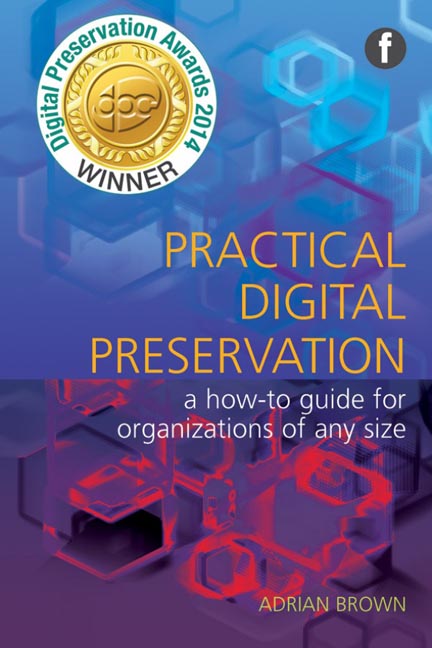Book contents
- Frontmatter
- Contents
- Acknowledgements
- Glossary
- 1 Introduction
- 2 Making the case for digital preservation
- 3 Understanding your requirements
- 4 Models for implementing a digital preservation service
- 5 Selecting and acquiring digital objects
- 6 Accessioning and ingesting digital objects
- 7 Describing digital objects
- 8 Preserving digital objects
- 9 Providing access to users
- 10 Future trends
- Appendices
- Bibliography
- Index
6 - Accessioning and ingesting digital objects
Published online by Cambridge University Press: 08 June 2018
- Frontmatter
- Contents
- Acknowledgements
- Glossary
- 1 Introduction
- 2 Making the case for digital preservation
- 3 Understanding your requirements
- 4 Models for implementing a digital preservation service
- 5 Selecting and acquiring digital objects
- 6 Accessioning and ingesting digital objects
- 7 Describing digital objects
- 8 Preserving digital objects
- 9 Providing access to users
- 10 Future trends
- Appendices
- Bibliography
- Index
Summary
Introduction
Accession is the process by which new content is brought within the intellectual and physical control of the repository. It can be divided into three broad types of activity:
• collating the content and metadata into a suitable form for ingest
• checking and enhancing that content and metadata where necessary, to ensure that it meets all the requirements for ingest
• ingesting the content and metadata into the repository.
The accession process is triggered by the conclusion of some form of selection decision and physical transfer, and concludes once the content is under the full control of the repository, and accessible to its user community.
Accession is likely to account for the majority of your activity when operating a digital repository, so it pays to ensure that you have an effective, efficient and robust process. Effort invested in getting this right will yield dividends in future – a good accession process will ensure that new content is securely stored, well documented and error-free, and will greatly simplify its future preservation and access; conversely, even the most effective future management regime may be unable to compensate for mistakes and omissions during accession.
This chapter provides a detailed description of the steps required to accession digital objects into a digital repository. It includes an assessment of the types of tool that are available to support these processes, and practical guidance on ‘first aid’ procedures for dealing with poorly documented, obsolete or unsolicited deposits. It ends with a series of case studies to further illustrate how these concepts can be put into practice.
Defining an accession process
Accession involves a standard series of steps or workflow, although every repository is likely to require subtle differences in the detail and order of those steps. A model accession workflow, illustrating those key steps, is shown in Figure 6.1.
The precursor to this workflow – pre-accession activity – encompasses everything that happens in the lifecycle of a digital collection from creation up to the point at which it is physically transferred to the digital repository. In the first step, a standard package of content and metadata, usually referred to as a SIP, is made available to the digital repository to begin the accession process; this step falls on the cusp of the transfer process, as discussed in Chapter 5, ‘Selecting and acquiring objects’.
- Type
- Chapter
- Information
- Practical Digital PreservationA how-to guide for organizations of any size, pp. 129 - 154Publisher: FacetPrint publication year: 2013



